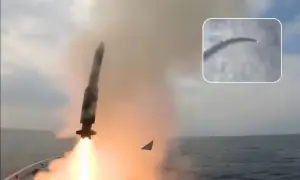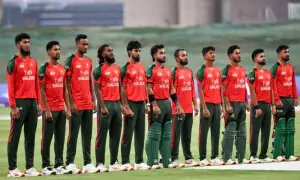Over 94% of people use unfiltered water in Peshawar, shows data
“I don’t remember if the administration or government has ever changed the water pipeline during my lifetime, we can’t do this work of the government by ourselves,” said Waris Khan, a 60-year-old resident of Akhunabad, an area located on Phandu Road in Peshawar.
He lamented that water coming out from the tube well was not clean as it flowed through leaked pipelines or dirty drains. Moreover, the water filtration plant installed with the tube well was closed after running for a day.
“Now not only the plant is inoperable, but the taps on the plant have also been stolen,” Khan said, adding that residents have no other option but to drink contaminated water.
Khan went on to add that often the water not only changes colour but also tastes rusty. “Due to drinking contaminated water, my family, especially children, usually have complaints of stomach diseases, while one of my sons was diagnosed with hepatitis.”
Zarmina Bibi, a resident of Shaheen Muslim Town, has to fetch water for drinking from the tube well in her area early in the morning as she goes through a similar ordeal to Khan.
When asked, Zarmina, 44, replied that taste and odour were signs for them to check whether the water was contaminated or not.
Population and sources of drinking water
Peshawar population, which was 4.3 million in the census 2017, was over 4.5 million after a 1.5% increase, according to the new digital census.
Seventy-one per cent of citizens in urban areas of Peshawar and 11% in rural areas were using drinking water from tube wells while the rest were consuming water from private sources such as water from bore, well or hand pump, as per the research of Iftikhar Ahmed, Mirajul Haq and Abdul Sattar from Pakistan Institute of Development Economics.
Citizens drink contaminated water
In its 2021 report, the Pakistan Council of Research in Water Resources (PCRWR) found that 50% of the water flowing from tube wells was unusable because of iron in it. The organisation feared that steel pipes or other plumbing components had led to its presence.
The PCRWR had taken water samples, after flowing for 10 minutes, from different tube wells in Peshawar. “Safe drinking water has decreased by 10% over the last 10 years which can be mostly due to tampered, old, rusty, substandard and open distribution pipelines,” said the report.
In her research on bacterial contamination in drinking water, Dr Bushra Khan, the associate professor of the Department of Environmental Science at the University of Peshawar, found that 88% samples out of the total 15 samples taken from the Tehkal, Shami Road, Nothia, Gulbahar, University of Peshawar, Agriculture University, Gulberg, Defence Colony and Hayatabad were against the guidelines of the World Health Organisation.
All of the above-mentioned areas exceeded WHO’s recommendations as total dissolved solids (TDS) in water was not less than 300 parts per million (PPM) while the drinking water had bacterial contamination at both source and consumer sites.

Water filtration plants
There were around 537 tube wells in Peshawar under the management of Water Sanitation Services Peshawar (WSSP), showed the data. It was obtained through an application (RTI) filed under the Khyber Pakhtunkhwa Right to Information Act 2013.
Only 38 – out of the 537 tube wells – have water filtration plants. And, eight out of the 38 were nonfunctional due to “various reasons”.
Moreover, each tube well was operated for about nine hours that providing 13,000 gallons or 49,140 litres of water in one hour while all 537 tube wells in total give more than 6.9 million gallons or 20 million litres in one hour while 60 million gallons or 230 million litres in 9 hours.
“There is no water filtration plant installed on 507 tube wells or they are damaged, therefore, more than 59 million gallons or 224 million litres of water are used daily from 507 tube wells without any filtration,” it shows. “Only 5.58% of citizens are using filtered water while 94.41% are using water without filters.”

Hepatitis, typhoid, cholera and polio likely to spread
Dr Tahir Khan, the registrar medicine unit in the Lady Reading Hospital, told Aaj News that drinking contaminated or dirty water could cause stomach and intestinal diseases including typhoid, hepatitis, and cholera while the presence of poliovirus in the sewage samples also raised the possibility of crippling disease spreading among children.
Around 54 polio cases have been reported in Peshawar since 2012, shows the Emergency Operation Center Khyber Pakhtunkhwa data. The statistics were reported by the Pakistan Polio Laboratory at the National Institute of Health report that confirmed the presence of poliovirus in 17 environmental samples in 2022 and 10 so far this year.
Similarly, the KP Health Department data shows that 90,291 typhoid, 164,309 cholera and 51,080 hepatitis cases have been reported since January 2022.
It merits here to mention that as per the World Health Organization, around 500 million cases of cholera occur every year in Asia alone due to unsafe water.

How to test water?
As per the Department of Public Health Engineering, about 20 tests were conducted to determine whether the results of these three parameters (physical, chemical and microbiological) were within the limits specified by WHO or Pakistan Standard and Quality Control Authority or not.
Dr Hafsa Muhammad, the assistant professor and biosafety officer at the Khyber Medical University in Peshawar, believed that strict adherence to biosafety SOPs in the laboratory while testing water samples was “extremely important.”
“If biological facilities or equipment are not cleaned or disinfected and become part of the environment or enter clean water, it can not only be a dangerous practice but also cause an outbreak,” Dr Hafsa explained.

Lack of Funds for Environmental Profile
KP Environmental Protection Agency Director General Mohammad Anwar Khan confirmed that it was the responsibility of the EPA to prepare an environmental profile in the province every year, but due to a lack of funds, the environmental profile was last prepared in 2017.
According to that profile, the quality of drinking water was found to be satisfactory in terms of physico-chemical and aesthetic parameters but bacteria were found in the water which was not up to drinking quality, increasing the risk of water-borne diseases.
Regular disinfection of the water supply was mandatory, but before that, it was necessary to identify contaminated water through environmental profile, for which the provincial government has proposed to release an amount of Rs15 million, the EPA DG stated.

The unchanged pipeline of 1947
Dr Muneebur Rehman, a research officer at the PCRWR, told Aaj News that it was the responsibility of the state to ensure the delivery of clean drinking water to every citizen. But he claimed that water being supplied through the pipeline to consumers was not safe because “more than 70% pipeline was unchanged after 1947.”
He claimed that 99% of filtration plants, installed at every union council under the ‘Clean Drinking Water for All (CDWA)’ campaign from 2008 to 2011, were now defunct due to “negligence and no proper maintenance” by departments concerned.
“In order to keep the filtration plants safe and functional, all must be handed over to local communities, so that in case of malfunction or pipe leakage, the people of that particular community can repair it themselves,” Dr Rehman opined.
Defunct water resource regulatory authority and commission
Dr Rehman was of the view that due to the lack of rules, the Khyber Pakhtunkhwa Water Act approved in 2020 was not being implemented. He alleged that the Water Resources Commission and the Water Resources Regularity Authority under the Water Act were ineffective and inactive.
He stressed the need for enforcing the Water Act in order to have a clean drinking water facility.
Under Section 22 of the Khyber Pakhtunkhwa Water Act 2020, provision of contaminated or unfit water was an offence, according to a document obtained from the KP Assembly website.
Under sections 22, 23, and 25 of the Act, powers have been given to the KP Water Resources Regulatory Authority to impose a fine of up to Rs500,000 or imprisonment for up to three months on a company, institution or person for supplying contaminated water through a pipeline while any person or persons found guilty of intentionally or negligently polluting water shall be liable to a fine of up to Rs100,000.
Engineer Muhammad Yaseen, the chief engineer South of KP Irrigation Department, said that water problems could be easily controlled in many districts of the province including Peshawar by implementing the law in actual spirit.
“Many letters have been sent to the government for the authority structure and the necessary appointments and recruitments, but no step has been taken thus far,” lamented Yaseen.
Yaseen, who is also the director general of KP Water Resources Regulatory Authority, went on to add that until and unless the recruitments and appointments were ensured the law and the authority under it were of no use because the DG solely cannot solve the problems.
Mehwish Mohib Kakakhil, a Peshawar High Court advocate, said that under the Water Act, the establishment of the Water Resources Commission and Water Resources Regulatory Authority was mandatory because without them the implementation of the law was not possible. She claimed that the government has failed to implement the Water Act 2020, as a result, the legislation was “useless so far.”
“It is the responsibility of the government to make legislation as well as implement it, but if the government does not show seriousness, then they will approach the Peshawar High Court for the establishment of an authority and a commission for the welfare of the people,” she said.
What WSSP does?
Hassan Ali, a spokesperson of the Water Sanitation Services Peshawar (WSSP), said that the underground water was drinkable but due to problems in the pipeline system at different places, most of the consumers were getting contaminated water, therefore, the WSSP has replaced 400 metres of the pipeline.
Ali stated that the WSSP has planned to change the entire pipeline—more than 1,500 metres of pipeline system under its management. “For this purpose, a project worth billions of rupees has been proposed to the government, and soon, after approval from the government, the entire pipeline system across the city will be replaced to provide clean drinking water to consumers,” he added.
Asian Development Bank Project for Clean Drinking Water
Only 42 per cent of the urban population of KP have access to water through the pipeline system, usually for only six hours a day, according to the document and information obtained under the access to information request from the Asian Development Bank.
However, contaminated water was being received due to significant damages in the pipe networks which puts an additional burden on women because they have to buy or store water. Therefore, with the support of the ADB, a project Khyber Pakhtunkhwa Cities Improvement Project worth more than $500 million has been initiated to improve the life of five cities of KP, including Peshawar.
“Project completing by 2028 aims to ensure supply of clean water along with support in other matters,” says the document.
How did diseases spread by contaminated water decrease?
According to PCRWR and WHO research, infectious intestinal diseases decreased by 72% and infectious eye diseases by 64% while the mortality rate of infants and young children fell to 52% after installing new water supply pipes in just 30 rural villages in Japan.
Similarly, in India’s Uttar Pradesh, improvements in waterworks, sewage and sanitation led to a 74% reduction in cholera mortality, 63% in typhoid and 23% in dysentery.

How to avoid drinking contaminated water?
Dr Bushra Khan suggested in her research that leaking pipes should be changed water tanks should be washed and chlorinated periodically and drinking water should be boiled before use to avoid contamination.
Muhammad Ali, a distributor of Aqua World Pvt Ltd KP, was of the view that the WHO recommended Total Dissolved Solids (TDS) in water must be less than 300PPM but the TDS level was higher than this, so drinking water in Peshawar was hazardous to health, therefore, installing a water filter at home was the best way to avoid drinking contaminated.
“A water filter costs around Rs50,000 which can provide more than 100 gallons or 350 litres of drinking water per day and the TDS level through the filter also comes up to 100PPM which is exactly WHO standard,” he added.
Dr Saeeda Yousaf, an associate professor at the Department of Environmental Sciences, University of Peshawar, reinstated that along with adopting the above methods, disinfectants (chemical disinfects) were available in the market, which could be added to water to obtain clean drinking water.
For the latest news, follow us on Twitter @Aaj_Urdu. We are also on Facebook, Instagram and YouTube.

















Comments are closed on this story.